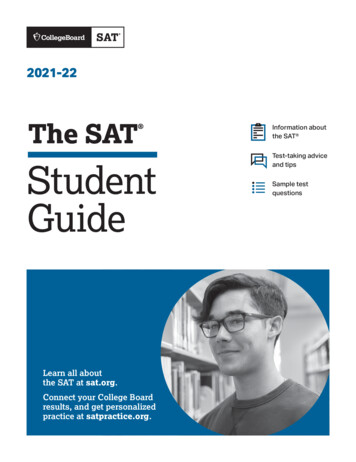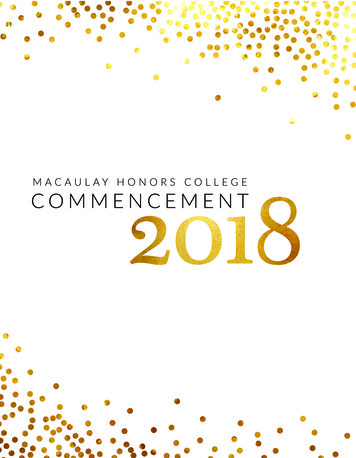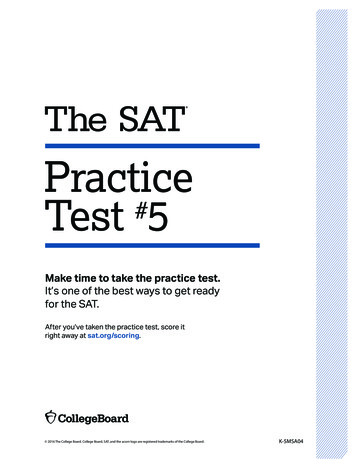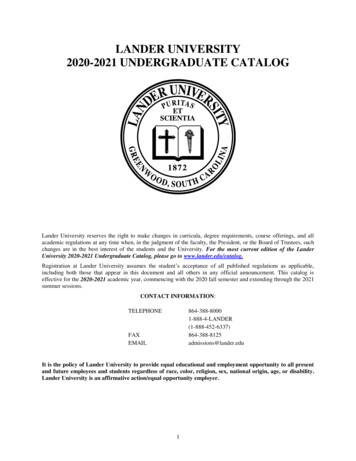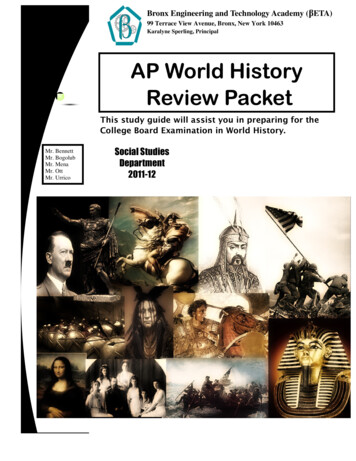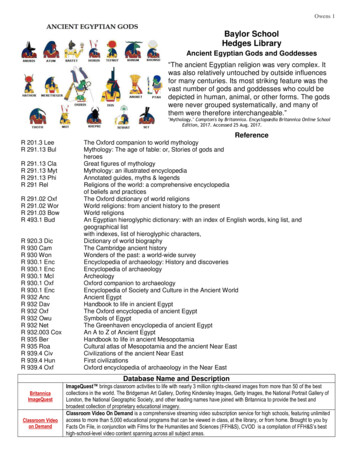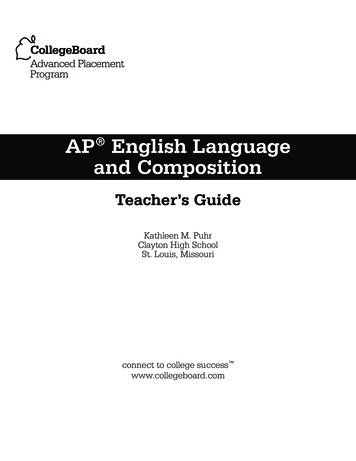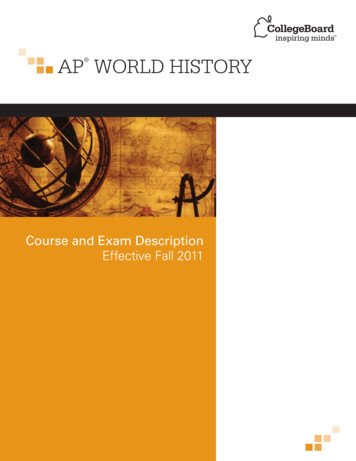
Transcription
AP WORLD HISTORY Course and Exam DescriptionEffective Fall 2011
The College BoardThe College Board is a mission-driven not-for-profit organization thatconnects students to college success and opportunity. Founded in 1900,the College Board was created to expand access to higher education.Today, the membership association is made up of more than 5,900 of theworld’s leading educational institutions and is dedicated to promotingexcellence and equity in education. Each year, the College Board helpsmore than seven million students prepare for a successful transition tocollege through programs and services in college readiness and collegesuccess — including the SAT and the Advanced Placement Program . Theorganization also serves the education community through research andadvocacy on behalf of students, educators and schools.For further information, visit www.collegeboard.comAP Equity and Access PolicyThe College Board strongly encourages educators to make equitableaccess a guiding principle for their AP programs by giving all willing andacademically prepared students the opportunity to participate in AP. Weencourage the elimination of barriers that restrict access to AP for studentsfrom ethnic, racial and socioeconomic groups that have been traditionallyunderserved. Schools should make every effort to ensure their AP classesreflect the diversity of their student population. The College Board alsobelieves that all students should have access to academically challengingcourse work before they enroll in AP classes, which can prepare them forAP success. It is only through a commitment to equitable preparation andaccess that true equity and excellence can be achieved.AP Course and Exam DescriptionsAP Course and Exam Descriptions are updated regularly. Please visit APCentral (apcentral.collegeboard.com) to determine whether a more recentCourse and Exam Description PDF is available. 2011 The College Board. College Board, ACCUPLACER, Advanced Placement Program,AP, AP Central, SAT, SpringBoard and the acorn logo are registered trademarks of the CollegeBoard. inspiring minds is a trademark owned by the College Board. PSAT/NMSQT is a registeredtrademark of the College Board and National Merit Scholarship Corporation. All other productsand services may be trademarks of their respective owners.
ContentsAbout Ap .1Offering AP Courses and Enrolling Students.1How AP Courses and Exams Are Developed.2How AP Exams Are Scored.3Using and Interpreting AP Scores.3Additional Resources.4Curriculum Framework.5Introduction.5The Four Historical Thinking Skills.71: Crafting Historical Arguments from Historical Evidence.82: Chronological Reasoning. .103: Comparison and Contextualization.134: Historical Interpretation and Synthesis.15Course Themes.171: Interaction Between Humans and the Environment.172: Development and Interaction of Cultures. .183: State-Building, Expansion, and Conflict.184: Creation, Expansion, and Interaction of Economic Systems. .195: Development and Transformation of Social Structures. .20Geographical Coverage. .21Historical Periodization.23Concept Outline. .23Period 1: Technological and Environmental Transformations,to c. 600 B.C.E. .25Period 2: Organization and Reorganization of HumanSocieties, c. 600 B.C.E. to c. 600 C.E. .31Period 3: Regional and Transregional Interactions, c. 600 C.E.to c. 1450. . 40Period 4: Global Interactions, c. 1450 to c. 1750.50Period 5: Industrialization and Global Integration, c. 1750 toc. 1900 .61Period 6: Accelerating Global Change and Realignments,c. 1900 to Present .74Participating in the AP Course Audit. 89Curricular Requirements.89Resource Requirements.90
Exam Information.91How the Curriculum Framework Is Assessed. .92Sample Multiple-Choice Questions. .93Answers to Multiple-Choice Questions.108Sample Free-Response Questions.108Part A: Document-Based Essay Question.109Part B: Continuity and Change-Over-Time Essay. 119Part C: Comparative Essay. .123
About APAbout AP AP enables students to pursue college-level studies while still in highschool. Through more than 30 courses, each culminating in a rigorousexam, AP provides willing and academically prepared students with theopportunity to earn college credit, advanced placement or both. Taking APcourses also demonstrates to college admission officers that students havesought out the most rigorous course work available to them.Each AP course is modeled upon a comparable college course, and collegeand university faculty play a vital role in ensuring that AP courses alignwith college-level standards. Talented and dedicated AP teachers help APstudents in classrooms around the world develop and apply the contentknowledge and skills they will need later in college.Performing well on an APExam means more than justthe successful completion ofa course; it is a gateway tosuccess in college. Researchconsistently shows thatstudents who score a 3 orhigher on AP Exams typicallyexperience greater academicsuccess in college and havehigher graduation rates thanotherwise comparable nonAP peers.*Each AP course concludes with a college-level assessment developed andscored by college and university faculty, as well as experienced AP teachers.AP Exams are an essential part of the AP experience, enabling studentsto demonstrate their mastery of college-level course work. More than 90percent of four-year colleges and universities in the United States grantstudents credit, placement or both on the basis of successful AP Examscores. Universities in more than 60 countries recognize AP Exam scoresin the admission process and/or award credit and placement for qualifyingscores. Visit www.collegeboard.com/ap/credit to view AP credit andplacement policies at more than 1,000 colleges and universities.Offering AP Courses and EnrollingStudentsThis AP Course and Exam Description details the essential informationrequired to understand the objectives and expectations of an AP course.The AP Program unequivocally supports the principle that each schooldevelops and implements its own curriculum that will enable students todevelop the content knowledge and skills described here.*See the following research studies for more details:Linda Hargrove, Donn Godin, and Barbara Dodd, College Outcomes Comparisons by AP andNon-AP High School Experiences, (New York: The College Board, 2008);Chrys Dougherty, Lynn Mellor, and Shuling Jian, The Relationship Between Advanced Placementand College Graduation, (Austin, TX: National Center for Educational Accountability, 2006).Additional AP studies are available at www.collegeboard.com/research.Return to the Table of Contents The College Board1
About APSchools wishing to offer AP courses must participate in the AP Course Audit, aprocess through which AP teachers’ syllabi are reviewed by college faculty. TheAP Course Audit was created at the request of College Board members whosought a means for the College Board to provide teachers and administratorswith clear guidelines on curricular and resource requirements for AP courses,and to help colleges and universities validate courses marked “AP” on students’transcripts. This process ensures that AP teachers’ syllabi meet the curricularand resource expectations that college and secondary school faculty haveestablished for college-level courses. For more information on the AP CourseAudit, visit www.collegeboard.com/apcourseaudit.The College Board strongly encourages educators to make equitableaccess a guiding principle for their AP programs by giving all willing andacademically prepared students the opportunity to participate in AP. Weencourage the elimination of barriers that restrict access to AP for studentsfrom ethnic, racial and socioeconomic groups that have been traditionallyunderserved. Schools should make every effort to ensure their AP classesreflect the diversity of their student population. The College Board alsobelieves that all students should have access to academically challengingcourse work before they enroll in AP classes, which can prepare them forAP success. It is only through a commitment to equitable preparation andaccess that true equity and excellence can be achieved.How AP Courses and Exams AreDevelopedAP courses and exams are designed by committees of college faculty andexpert AP teachers who ensure that each AP subject reflects and assessescollege-level expectations. To find a list of each subject’s current APDevelopment Committee members, please visit: apcentral.collegeboard.com/development committees. AP Development Committees define thescope and expectations of the course, articulating through a curriculumframework what students should know and be able to do upon completionof the AP course. Their work is informed by data collected from a rangeof colleges and universities to ensure that AP course work reflects currentscholarship and advances in the discipline.The AP Development Committees are also responsible for drawing clearand well-articulated connections between the AP course and AP Exam —work that includes designing and approving exam specifications and examquestions. The AP Exam development process is a multiyear endeavor;all AP Exams undergo extensive review, revision, piloting and analysisto ensure that questions are high-quality and fair, and that there is anappropriate spread of difficulty across the questions.2Return to the Table of Contents The College Board
About APThroughout AP course and exam development, the College Board gathersfeedback from various stakeholders in both secondary schools and highereducation institutions. This feedback is carefully considered to ensurethat AP courses and exams are able to provide students with a collegelevel learning experience and the opportunity to demonstrate theirqualifications for advanced placement upon college entrance.How AP Exams Are ScoredThe exam scoring process, like the course and exam development process,relies on the expertise of both AP teachers and college faculty. Whilemultiple-choice questions are scored by machine, the free-responsequestions are scored by thousands of college faculty and expert AP teachersat the annual AP Reading. AP Exam Readers are thoroughly trained,and their work is monitored throughout the Reading for fairness andconsistency. In each subject, a highly respected college faculty member fillsthe role of Chief Reader, who, with the help of AP Readers in leadershippositions, maintains the accuracy of the scoring standards. Scores on thefree-response questions are weighted and combined with the results of thecomputer-scored multiple-choice questions, and this raw score is summedto give a composite AP score of 5, 4, 3, 2 or 1.The score-setting process is both precise and labor intensive, involvingnumerous psychometric analyses of the results of a specific AP Exam in aspecific year and of the particular group of students who took that exam.Additionally, to ensure alignment with college-level standards, part of thescore-setting process involves comparing the performance of AP studentswith the performance of students enrolled in comparable courses incolleges throughout the United States. In general, the AP composite scorepoints are set so that the lowest raw score needed to earn an AP score of 5is equivalent to the average score among college students earning gradesof A in the college course. Similarly, AP Exam scores of 4 are equivalentto college grades of A-, B and B. AP Exam scores of 3 are equivalent tocollege grades of B-, C and C.Using and Interpreting AP ScoresThe extensive work done by college faculty and AP teachers in thedevelopment of the course and the exam and throughout the scoringprocess ensures that AP Exam scores accurately represent students’achievement in the equivalent college course. While colleges anduniversities are responsible for setting their own credit and placementpolicies, AP scores signify how qualified students are to receive collegecredit or placement:Return to the Table of Contents The College Board3
About APAP ScoreQualification5Extremely well qualified4Well qualified3Qualified2Possibly qualified1No recommendationAdditional ResourcesVisit apcentral.collegeboard.com for more information about the APProgram.4Return to the Table of Contents The College Board
AP World History Curriculum FrameworkCurriculum FrameworkIntroductionThe breadth of world history has always posed challenges for AP teachersto create opportunities for deep conceptual understanding for studentswhile addressing a syllabus largely driven by sheer scope. The AP WorldHistory course outlined in this course and exam description addressesthese challenges by providing a clear framework of six chronologicalperiods viewed through the lens of related key concepts and course themes,accompanied by a set of skills that clearly define what it means to thinkhistorically.The course’s organization around a limited number of key concepts insteadof a perceived list of facts, events, and dates makes teaching each historicalperiod more manageable. The three to four key concepts per perioddefine what is most essential to know about each period based uponthe most current historical research in world history. This approachenables students to spend less time on factual recall, more time on learningessential concepts, and helps them develop historical thinking skillsnecessary to explore the broad trends and global processes involved intheir study of AP World History.To foster a deeper level of learning, the framework distinguishes contentthat is essential to support the understanding of key concepts from contentexamples that are not required. Throughout the framework, possibleexamples of historical content are provided in the right-hand columnas an illustration of the key concept, but these illustrative examples arenot required features of the course or required knowledge for the exam.Instead, the illustrative examples are provided to offer teachers a variety ofoptional instructional contexts that will help their students achieve deeperunderstanding. In this way the framework provides teachers freedom totailor instruction to the needs of their students and offers flexibility inbuilding upon their own strengths as teachers.The themes and key concepts are intended to provide foundationalknowledge for future college-level course work in history. Command of thesecourse themes and key concepts requires sufficient knowledge of detailedand specific relevant historical developments and processes — includingnames, chronology, facts, and events — to exemplify the themes and keyconcepts. However, the specific historical developments and processestaught in an AP World History course will vary by teacher according to theinstructional choices each teacher makes to provide opportunities for studentinvestigation and learning for each key concept and theme.Return to the Table of Contents The College Board5
AP World History Curriculum FrameworkOverview of ComponentsThe AP World History course content is structured around theinvestigation of five course themes and 19 key concepts in six differentchronological periods, from approximately 8000 B.C.E. to the present. The Four Historical Thinking SkillsThe framework defines a set of shared historical thinking skills,which allows teachers to make more informed choices aboutappropriate ways of linking content and thinking skills. Key Concepts and ThemesooThe use of key concepts and themes to organize the coursefacilitates both chronological and thematic approaches toteaching AP World History. Given the vast nature of thesubject matter, using both approaches — even alternatingbetween the two — often aids instruction.ooThe key concepts support the investigation of historicaldevelopments within a chronological framework, while thecourse themes allow students to make crucial connectionsacross the six historical periods and across geographicalregions.ooThe concepts are designed to provide structure forteaching the course, serving as instructional units that canbe addressed separately or in conjunction with other keyconcepts within any given period.ooBy framing historical processes and developments beyonda perceived list of facts, events, and dates, the key conceptshelp teachers and their students understand, organize,and prioritize historical developments within eachperiod. So the framework provides a comprehensivecontent outline organized by key concepts.Overall, the framework gives teachers the flexibility to teach each keyconcept in a variety of ways, providing greater options for designinginstruction. The AP World History course develops students’ capacityand ability to think and reason in a deeper, more systematic way, betterpreparing them for subsequent college courses. The skills, course themes,periodization, and key concepts are explained in detail in the curriculumframework that follows.6Return to the Table of Contents The College Board
AP World History Curriculum FrameworkThe Four Historical Thinking SkillsHistory is a sophisticated quest for meaning about the past, beyond theeffort to collect information. Historical analysis requires familiarity with agreat deal of information, including names, chronology, facts, and events.Without reliable and detailed information, historical thinking is notpossible. Yet historical analysis involves much more than the compilationand recall of data; it also requires several distinctive historical thinkingskills.The four historical thinking skills presented below, along with thedescriptions of the components of each skill, provide an essential structurefor learning to think historically. These skills not only apply to AP WorldHistory; they also represent the type of skills required in all college-levelhistorical scholarship. The interaction of skills and content found in thiscourse is an approach that emphasizes historical scholarship’s reliance ondiverse sources, each of which may reveal a different facet of the past.All historical research and teaching use historical thinking skills. However,different subdisciplines may approach these skills in different ways andemphasize some of the skills more than others. Two main features of worldhistory help explain its uniqueness. First, world history is a relatively newsubdiscipline of history. It acquired a distinct identity only in the finaldecades of the twentieth century. Second, world history embraces longertime periods, larger geographical areas and much more human historythan traditional subdisciplines such as U.S. history and European history.These distinctive challenges posed by world history provide wonderfulopportunities to help students understand historiography, the study of thedifferent methods or approaches various historians use to construct theiraccounts of the past. Each of the four historical thinking skills supportdeep understandings and relevant applications of historical knowledge, asoutlined in this section.Helping Students Develop Proficiency in theHistorical Thinking SkillsThe curriculum framework clearly defines each skill component and thendescribes the desired skill proficiency for that component. The descriptionof what students should be able to do to demonstrate a particular skillcomponent provides a target for student learning throughout the year.The description of how students can develop this level of proficiencydemonstrates how students might progress toward this target. AP teacherscan use this information to develop better insight into individual studentperformance and adjust curriculum and instruction accordingly.Return to the Table of Contents The College Board7
AP World History Curriculum FrameworkDesigning a variety of learning experiences using the increasinglysophisticated verbs shown below facilitates student development of eachhistorical thinking skill. The diagram demonstrates how students mightprogress from tasks that begin with the skills of definition and descriptionand eventually reach tasks involving more sophisticated skills such assynthesis and critique. Tasks, such as compare or contextualize, wouldbecome more challenging based on the complexity and number of thehistorical processes under structStructure of the Historical Thinking Skills SectionIn order to provide teachers with the information they need to incorporatehistorical thinking skills into an AP World History classroom, each skillcomponent in this section includes the following: A definition of the skill component from the perspective of aprofessional historian, regardless of historical field. A description of desired proficiency for high achievement in anintroductory college-level history course (which is comparable toan AP history course). This includes:ooWhat students should be able to do to demonstrate eachskill component; andooHow students can develop this level of proficiency, if theyhaven’t already. An explanation of how this skill could be approachedinstructionally within the context of an AP World History course.1. Crafting Historical Arguments from HistoricalEvidenceHistorical ArgumentationHistorical thinking involves the ability to define and frame a questionabout the past and to address that question through the constructionof an argument. A plausible and persuasive argument requires a clear,comprehensive and analytical thesis, supported by relevant historicalevidence — not simply evidence that supports a preferred or preconceivedposition. Additionally, argumentation involves the capacity to describe,analyze, and evaluate the arguments of others in light of available evidence.8Return to the Table of Contents The College Board
AP World History Curriculum FrameworkWhat should students be able to do to demonstrateHistorical Argumentation?At the end of an introductory college-level history course, the mostable students should be able to construct meaningful interpretationsthrough sophisticated analysis of disparate, relevant historicalevidence. They should also be able to evaluate and synthesizeconflicting historical evidence to construct persuasive historicalarguments.How can students develop this level of proficiency, if theyhaven’t already?Students might begin by describing commonly accepted historicalarguments (i.e., formulaic repetition of material provided in textsand classroom instruction) and explain how an argument has beenconstructed from historical evidence. Students might then progressto evaluating conflicting historical evidence in constructing plausiblehistorical arguments.How could this skill be approached within the context ofan AP World History course?In world history, historical argumentation often operates onexceptionally large scales. For example, instead of being askedto consider the Industrial Revolution in Europe in the earlynineteenth century, students might be asked to consider the impactof industrialization on several regions of the world from the earlynineteenth century to the present. The basic skills of argumentationare similar, but the scale on which they are applied is broader.Appropriate Use of Relevant Historical EvidenceHistorical thinking involves the ability to identify, describe, and evaluateevidence about the past from diverse sources (including writtendocuments, works of art, archaeological artifacts, oral traditions, andother primary sources), with respect to content, authorship, purpose,format, and audience. It involves the capacity to extract useful information,make supportable inferences and draw appropriate conclusions fromhistorical evidence while also understanding such evidence in its context,recognizing its limitations and assessing the points of view that it reflects.Return to the Table of Contents The College Board9
AP World History Curriculum FrameworkWhat should students be able to do to demonstrateAppropriate Use of Relevant Historical Evidence?At the end of an introductory college-level history course, the mostable students should be able to consistently analyze such featuresof historical evidence as audience, purpose, point of view, format,argument, limitations, and context germane to the historicalevidence considered. Based on their analysis and evaluation ofhistorical evidence, students should also be able to make supportableinferences and draw appropriate conclusions, placing the evidence inits context.How can students develop this level of proficiency, if theyhaven’t already?Students might begin by analyzing one or more of the followingfeatures: audience, purpose, point of view, format, argument,limitations, and context germane to the historical evidenceconsidered. Based on their analysis of historical evidence, studentsmight then progress to making supportable inferences or drawingappropriate conclusions.How could this skill be approached within the context ofan AP World History course?World history deals with such a diversity of eras, regions, and typesof society that it must also use a greater diversity of sources. Forexample, unlike AP U.S. History or AP European History, which relymost heavily on written sources, much of the scope of world historytakes place before writing developed or in societies where literacywas limited or nonexistent. Therefore, scholars of world history mayuse artifacts or oral traditions to try to understand those cultures.2. Chronological ReasoningHistorical CausationHistorical thinking involves the ability to identify, analyze, and evaluate therelationships between multiple historical causes and effects, distinguishingbetween those that are long-term and proximate, and among coincidence,causation, and correlation.10Return to the Table of Contents The College Board
AP World History Curriculum FrameworkWhat should students be able to do to demonstrateHistorical Causation?At the end of an introductory college-level history course, the mostable students should assess historical contingency, for example, bydistinguishing among coincidence, causation, and correlation, aswell as critiquing standard interpretations of cause and effect.How can students develop this level of proficiency, if theyhaven’t already?Students might begin by identifying and comparing basic causesand/or effects, such as between short- and long-term ones. Studentsmight then progress to analyzing and evaluating the interaction ofmultiple causes and/or effects.How could this skill be approached within the context ofan AP World History course?In world history, arguments about causation are similar to those inother subdisciplines, although they often span much larger periodsand regions.Patterns of Continuity and Change Over TimeHistorical thinking involves the ability to recognize, analyze, and evaluatethe dynamics of historical continuity and change over periods of timeof varying length, as well as relating these patterns to larger historicalprocesses or themes.What should students be able to do to demonstratePatterns of Continuity and Change Over Time?At the end of an introductory college-level history course, the mostable students should be able to analyze and evaluate historicalpatterns of continuity and change over time, making connections tocourse themes and global processes.How can students develop this level of proficiency, if theyhaven’t already?Students might begin by recognizing instances of historical patternsof continuity and change over time. Students might then progress todescribing these patterns.Return to the Table of Contents The College Board11
AP World History Curriculum FrameworkHow could this skill be approached within the context ofan AP World History course?This skill is particularly important in world history. World historiansfrequently have to look for very large patterns of continuity andchange. This scale can make world history seem somewhat abstractbecause individuals do not loom so large; on the other hand, worldhistory can
Ap World History Curriculum Framework 5 Curriculum Framework Introduction The breadth of world history has always posed challenges for AP teachers to create opportunities for deep conceptual understanding for students while addressing a syllabus largely driven by sheer scope. The AP World History course outlined in this course and exam .File Size: 2MB



